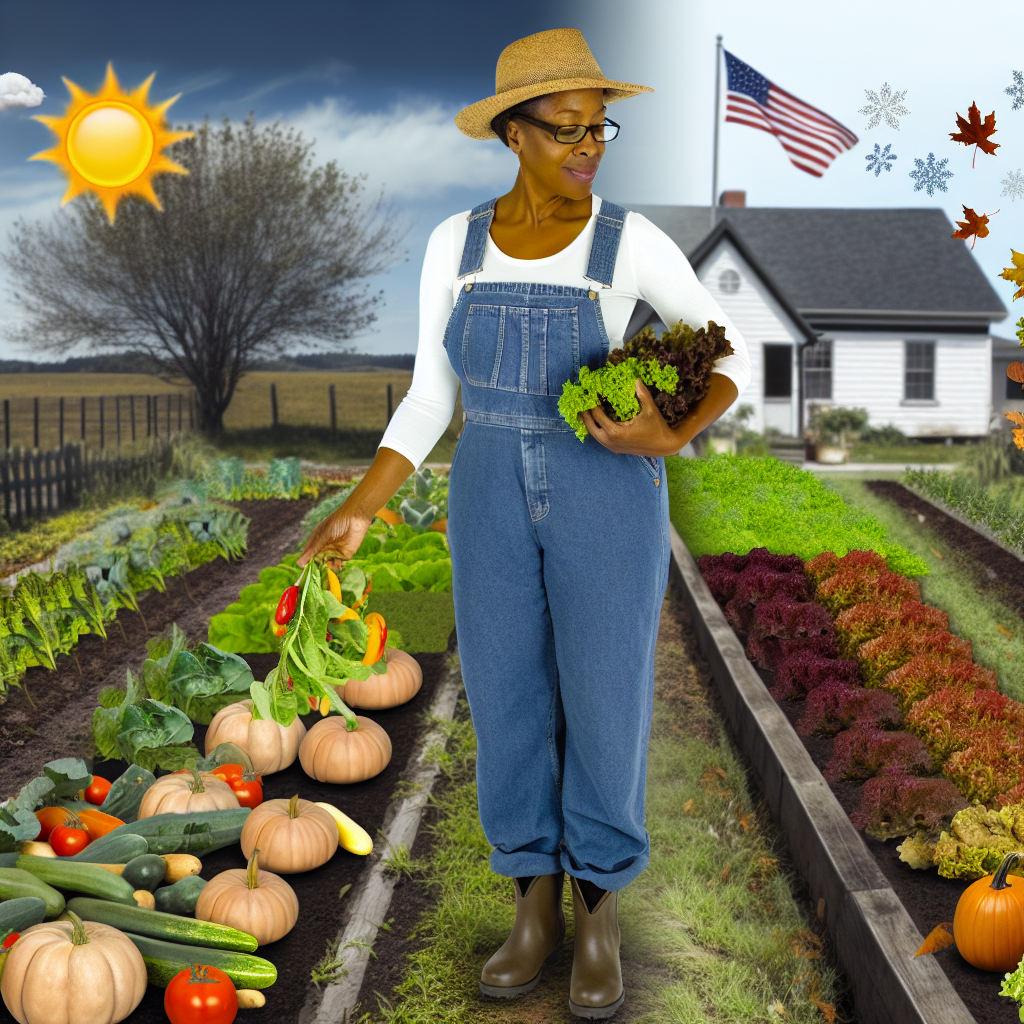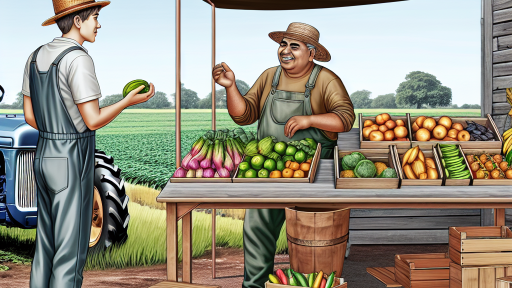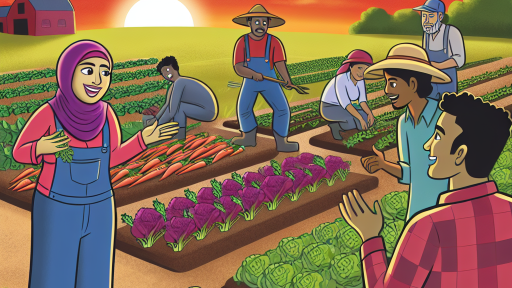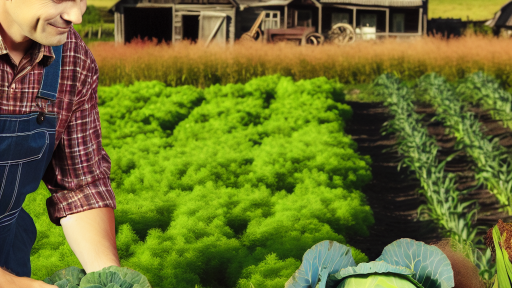Understanding Seasonal Eating
Concepts of Seasonal Eating
Seasonal eating involves consuming foods at their peak freshness.
This practice aligns with local harvest cycles.
Farmers grow and sell crops when they are in season.
For example, tomatoes are best in summer.
This also encourages consumers to try new foods throughout the year.
Benefits of Seasonal Eating
One significant benefit is improved taste and nutrition.
Freshly harvested foods retain more nutrients.
Additionally, seasonal foods often contain better flavor profiles.
This approach also supports local economies.
Buying local reduces transportation costs and emissions.
Furthermore, seasonal eating fosters sustainable farming practices.
It encourages crop diversity and healthier soil management.
Challenges of Seasonal Eating
One challenge is the limited availability of certain foods.
Consumers may find some favorites unavailable during off-seasons.
Also, local farmers may face unpredictable weather conditions.
Transform Your Agribusiness
Unlock your farm's potential with expert advice tailored to your needs. Get actionable steps that drive real results.
Get StartedThis can impact crop yields and availability.
Education about seasonal cycles can alleviate some challenges.
Making Seasonal Eating Work
Growing a variety of crops can help meet seasonal demands.
Farmers can plan planting schedules based on market trends.
Participating in local farmers’ markets connects growers and consumers.
Additionally, using preservation methods extends seasonal benefits.
- Canning and pickling foods can provide year-round access.
- Freezing fresh produce maintains flavor and nutrients.
Assessing Local Climate: How It Influences Seasonal Crops
Understanding Local Weather Patterns
Local weather patterns have a significant impact on farming operations.
Farmers must analyze seasonal climate data for effective planning.
For example, temperature trends can determine crop viability.
Rainfall patterns influence water availability for crops.
Additionally, wind patterns can affect crop orientation and growth.
Understanding these variables enables farmers to optimize their yields.
Identifying Suitable Crops
Selecting the right crops depends on local climate conditions.
Farmers should consider native species that thrive in their area.
Seasonal crops must align with the local growing season.
For instance, cool-season crops work best in spring and fall.
In contrast, warm-season crops flourish during summer months.
Adapting to Seasonal Changes
Farmers need to adapt their practices as seasons change.
This requires monitoring climate forecasts regularly.
Early planting can take advantage of shorter growing seasons.
Farmers might also utilize season-extended methods like greenhouses.
These adaptations can lead to greater resilience in crop yields.
Utilizing Technology for Climate Assessment
Technology plays a crucial role in assessing local climates.
Farmers can use weather apps to track conditions dynamically.
Showcase Your Farming Business
Publish your professional farming services profile on our blog for a one-time fee of $200 and reach a dedicated audience of farmers and agribusiness owners.
Publish Your ProfileThis technology provides timely alerts for unexpected weather.
Remote sensing tools can also help monitor soil moisture levels.
Utilizing these tools can enhance decision-making processes.
Collaborating with Local Agricultural Experts
Engaging with local agricultural experts benefits farmers significantly.
These experts can provide insights on climate trends and challenges.
Networking within local farming communities fosters knowledge sharing.
Workshops and seminars often present valuable information.
Collaboration enhances the effectiveness of farming strategies.
Mapping Out Seasonal Crop Rotation
Understanding Seasonal Crop Rotation
Seasonal crop rotation involves changing the types of crops grown in a specific area each season.
This practice enhances soil health and reduces pest problems.
Moreover, it helps farmers maximize yields throughout the year.
Benefits of Seasonal Eating
Seasonal eating promotes fresher produce for local communities.
It also supports local farmers by encouraging the purchase of in-season crops.
Additionally, it minimizes the carbon footprint associated with transporting food.
Planning Your Seasonal Crop Rotation
Begin by assessing your local climate and soil conditions.
Understanding your growing season is essential for effective planning.
Next, choose a diverse range of crops suitable for your climate.
Developing a Crop Calendar
Create a crop calendar to outline planting and harvesting times.
This visual aid simplifies tracking seasonal changes in your crops.
Include information about crop varieties that thrive in each season.
Implementing Crop Diversity
Diverse crop planting reduces reliance on single crops.
This practice mitigates risks associated with pests and diseases.
Moreover, it improves soil health by replenishing nutrients.
Incorporating Cover Crops
Cover crops play a critical role in maintaining soil health during off-seasons.
They prevent erosion and improve soil fertility.
Additionally, they can suppress weeds effectively, further benefiting your main crops.
Monitoring and Adjusting Your Rotation Plan
Regularly monitor soil health and crop performance each year.
Be prepared to adjust your rotation based on these observations.
Flexibility will ensure you maximize productivity and sustainability.
Collaborating with Local Farmers
Engage with local farming communities for shared insights and experiences.
Cooperating can enhance your understanding of crop rotation.
Sharing resources will benefit the entire agricultural community.
Delve into the Subject: Seasonal Agri-Tourism Ideas for Every Farm
Choosing Vegetables and Fruits for Different Seasons
Spring Selections
Spring brings fresh beginnings.
It’s the perfect time for planting cool-season crops.
Consider including leafy greens in your planting schedule.
Spinach and lettuce thrive in cooler temperatures.
Radishes also grow quickly, making them an excellent choice.
Additionally, peas flourish in spring weather.
They enrich the soil and enhance your crop rotation.
Showcase Your Farming Business
Publish your professional farming services profile on our blog for a one-time fee of $200 and reach a dedicated audience of farmers and agribusiness owners.
Publish Your ProfileSummer Choices
As temperatures rise, shift focus to warm-season vegetables.
Tomatoes are a favorite among summer crops.
Yellow squash and cucumbers are also popular for their high yields.
They flourish in warmer soil and provide a bounty of produce.
Don’t forget to plant peppers, which come in various colors and flavors.
They add diversity to your summer harvest.
Autumn Crops
Autumn is a time for hearty vegetables.
Consider planting root vegetables like carrots and beets.
Brassicas, such as kale and broccoli, also thrive in cooler autumn temperatures.
They develop deeper flavors after frost.
Furthermore, pumpkins are an essential part of the fall harvest.
They offer great versatility in recipes.
Winter Considerations
Winter may seem barren, but winter crops can thrive.
Choose hardy varieties such as winter spinach and Swiss chard.
These plants withstand frost and are available for harvest even in colder months.
They provide nutrition during lean times.
Additionally, garlic is often planted in autumn for a summer harvest.
It adds flavor and variety to your farm’s offerings.
Rotation and Diversity
Crop rotation plays a crucial role in maintaining soil health.
Rotate your vegetables to prevent pest buildup and nutrient depletion.
Diversifying your crops helps protect against market fluctuations.
It also ensures that your farm remains productive throughout the year.
Consider incorporating fruits that bear different seasons to balance your harvests.
This will maximize your farm’s potential.
Explore Further: Sustainable Practices in Farm-to-School Projects
Implementing Seasonal Recipes into Your Marketing Strategy
Understanding Seasonal Eating
Seasonal eating emphasizes consuming food that is in season.
This practice enhances flavor and nutritional value.
Moreover, it supports local farmers and the economy.
Creating seasonal recipes can engage your audience effectively.
Developing Seasonal Recipe Content
Start by sourcing seasonal ingredients from your farm.
Then, create a variety of recipes that highlight these ingredients.
Share these recipes through your marketing channels.
Consider using videos to demonstrate the cooking process.
- Video tutorials attract significant viewer engagement.
- Food photography showcases the beauty of seasonal dishes.
Incorporating Recipes into Promotions
Use seasonal recipes in your promotional materials.
For instance, include recipes in newsletters sent to subscribers.
Furthermore, host events centered around cooking with seasonal ingredients.
Engaging customers encourages return visits and loyalty.
- Farm-to-table dinners can create memorable experiences.
- Collaborate with local chefs for cooking demonstrations.
Engaging with Your Audience
Encourage followers to share their own seasonal recipes.
Use social media platforms to create community interaction.
Host contests to reward the best recipe submissions.
Showcase Your Farming Business
Publish your professional farming services profile on our blog for a one-time fee of $200 and reach a dedicated audience of farmers and agribusiness owners.
Publish Your ProfileThis strategy increases engagement and builds brand loyalty.
Monitoring and Adapting Your Strategy
Regularly assess the effectiveness of your marketing strategy.
Gather feedback from customers about the recipes you share.
Be open to adapting your approach based on this feedback.
Continually update your recipes to reflect seasonal changes.
Gain More Insights: Financial Planning Strategies for Community Supported Agriculture
Building Relationships with Local Chefs and Restaurants for Seasonal Products
Understanding the Importance of Local Partnerships
Local partnerships enhance the farming experience.
They provide farmers with a direct market for seasonal produce.
Additionally, these relationships can promote community resilience.
Chefs appreciate fresh, high-quality ingredients.
This demand creates opportunities for producers.
Identifying Potential Chefs and Restaurants
Start by researching local restaurants in your area.
Look for establishments that emphasize seasonal menus.
Consider restaurants that prioritize locally sourced ingredients.
These businesses often value quality over quantity.
Compile a list of chefs who are committed to sustainability.
Engaging with Local Dining Establishments
Reach out to chefs through social media platforms.
Attend local food events to meet chefs face-to-face.
Introduce yourself and discuss your farming practices.
Share your passion for seasonal eating with them.
Offer to provide samples of your produce.
Creating Win-Win Collaborations
Establish a mutual understanding of each other’s needs.
Set clear expectations regarding volume and delivery schedules.
Discuss how you can support one another through marketing.
Feature their dishes made with your produce on your website.
Encourage them to promote your farm to their patrons.
Maintaining Long-Term Relationships
Foster these relationships through regular communication.
Check in with chefs about their needs and feedback.
Consistently deliver high-quality products to build trust.
Offer seasonal specials or bespoke produce to keep them engaged.
Participate in collaborative events, such as farm-to-table dinners.
Discover More: Benefits Of Ethical Farming Methods

Creating a Seasonal Eating Calendar for Your Customers
Understanding Seasonal Produce
Seasonal produce varies throughout the year.
It reflects what is grown during specific months.
Consumers benefit from fresher, tastier options.
They also support local farming practices.
Mapping Out Your Calendar
Begin by identifying local growing seasons.
Research regional crops and their peak harvesting times.
This will inform your calendar content.
Consider factors like weather and climate variations.
Showcase Your Farming Business
Publish your professional farming services profile on our blog for a one-time fee of $200 and reach a dedicated audience of farmers and agribusiness owners.
Publish Your ProfileHighlighting Seasonal Recipes
Include recipes that feature seasonal ingredients.
Engage your customers with cooking tips and preparation methods.
Share ideas for using produce creatively.
This enhances customer experience and promotes seasonal eating.
Communicating with Customers
Utilize email newsletters to share the calendar.
Leverage social media to provide regular updates.
Create visually appealing graphics showcasing seasonal produce.
Encourage customer interaction by sharing recipes and meal ideas.
Incorporating Events and Promotions
Plan events that celebrate seasonal themes.
Host harvest festivals or cooking demonstrations.
Offer discounts or promotions for seasonal items.
This generates excitement and encourages purchases.
Evaluating and Adapting Your Calendar
Gather feedback from your customers regularly.
Monitor sales data to identify trends.
Adjust your calendar based on seasonal yield variations.
This ensures your offerings remain relevant and appealing.
Sustainable Practices for Year-Round Production
Embracing Seasonal Variety
Incorporating seasonal eating strengthens your farming operation.
This practice cultivates a diverse range of crops throughout the year.
Moreover, it enhances soil health and reduces pest outbreaks.
Crops like kale and spinach thrive in cooler months.
In contrast, tomatoes and peppers flourish in warmer seasons.
Implementing Crop Rotation
Crop rotation is essential for sustainable farming.
This method prevents soil nutrient depletion and lowers disease risks.
By alternating planting seasons, farmers can maximize yields.
Additionally, it helps manage pest populations naturally.
Farmers can use legumes to fix nitrogen in the soil.
Utilizing Cover Crops
Cover crops play an important role in sustainable agriculture.
They protect soil from erosion during off-seasons.
Furthermore, they improve soil structure and fertility.
Farmers can plant clover or rye as effective cover crops.
These plants provide habitat for beneficial insects.
Adopting Sustainable Water Practices
Water management is crucial for year-round production.
Irrigation systems should be efficient and tailored to crop needs.
Rainwater harvesting can significantly reduce water demand.
Implementing drip irrigation minimizes evaporation and runoff.
This approach also conserves water while maximizing plant growth.
Encouraging Local Food Systems
Building local food networks supports seasonal eating.
Consumers appreciate fresh produce directly from farms.
Farmers’ markets and community-supported agriculture foster community ties.
These connections promote sustainability and economic resilience.
Showcase Your Farming Business
Publish your professional farming services profile on our blog for a one-time fee of $200 and reach a dedicated audience of farmers and agribusiness owners.
Publish Your ProfileMoreover, they reduce transportation costs and carbon footprints.
Fostering Biodiversity
Biodiversity enhances resilience in farming systems.
Planting a variety of crops creates a balanced ecosystem.
This practice attracts beneficial insects and pollinators.
Additionally, it reduces the likelihood of crop failure.
Farmers should consider intercropping and polyculture methods.
Continuous Education and Adaptation
Farmers must stay informed about sustainable practices.
Workshops and online resources provide valuable insights.
Networking with other farmers can encourage knowledge sharing.
Moreover, adapting practices based on feedback leads to improvement.
Embracing change is vital for sustainable agriculture success.
Educating Consumers: Workshops and Events Focused on Seasonal Eating
Importance of Seasonal Eating
Seasonal eating enhances the connection between consumers and local farms.
This practice supports local economies by encouraging purchases from nearby growers.
Moreover, eating seasonally reduces the carbon footprint associated with transportation.
It also promotes freshness, resulting in better taste and nutritional value.
Setting Up Workshops
Workshops provide a hands-on approach to learning about seasonal produce.
Farmers can organize these events on-site to engage consumers directly.
Additionally, using social media to promote workshops widens participation.
Participants can learn how to select, store, and prepare seasonal foods.
Creating Community Events
Community events can showcase local harvests and promote seasonal recipes.
Organizing farmers’ markets can further enhance visibility and accessibility.
Cooking demonstrations featuring seasonal ingredients attract diverse audiences.
Regular events help build a loyal customer base while educating the public.
Partnering with Local Chefs
Collaboration with local chefs enriches the workshop experience.
Chefs can share recipes that highlight local, seasonal ingredients.
Having guest speakers keeps workshops dynamic and intriguing for attendees.
Furthermore, this partnership can lead to unique marketing opportunities.
Utilizing Online Platforms
Online platforms can extend the reach of seasonal eating workshops.
Webinars can engage consumers who cannot attend in-person events.
Additionally, sharing recorded sessions can benefit a larger audience post-event.
Engaging blogs and social media posts can spark ongoing conversations.
Feedback and Continuous Improvement
Gathering feedback after events helps improve future offerings.
Surveys can assess participant satisfaction and learning outcomes.
This information allows farmers to tailor future workshops accordingly.
Continuous improvement ensures events remain relevant and valuable.




